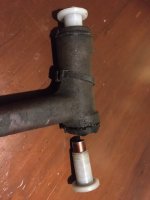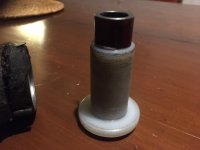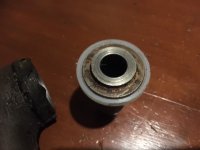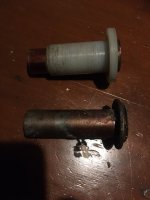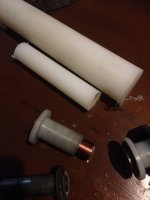Thanks, that's very useful. A couple of things mentioned which are helpful; that the overall fitting compression is about 2mm and all in the outer rubber, and the inner bush is referred to as nylon

You are using an out of date browser. It may not display this or other websites correctly.
You should upgrade or use an alternative browser.
You should upgrade or use an alternative browser.
CX lower control arm bushes
- Thread starter palyasm
- Start date
Great, thanks that is useful - makes sense that all the flex is provided by the outer rubber and the moving bush is nylon not urethane. So the thickness of the flange should be easy to determine by direct measurement rather than trying to work out the uncompressed thickness, as all the compression / preload is provided by the outer rubber...
Shane, I read through your thread back in 2014 re your struggles with removing the lower arms - how have the bronze bushes you made held up?
That was JBN, not meShane, I read through your thread back in 2014 re your struggles with removing the lower arms - how have the bronze bushes you made held up?
Continuing this thread for the knowledge-base:
I have turned up the (prototype) nylon bushes pictured below.
The 'thrust' end is cut from 50mm stock and the bush from 30mm. The process for the bush is to drill the hole and bore it to be a tight fit on the steel tube, then turn the outer diameter 27mm, once fitted to the tube. I've worked on 2.25mm thick for each thrust end, with a recess to fit the flange, for a wider seal area inside the outer diameter of the arm insert. I haven't fitted the arms into the subframe yet, so I may need to adjust my measurement of the thrust piece to get decent preload.
I haven't decided yet whether 'grease pockets' replicating the waffle on the original are necessary or not. What was left of the original bushes was crumbly like a good cheddar, clearly the result of degradation from either the grease or LHM, so maybe less volume of grease is better (with nylon) and also the waffle effectively gives far less bearing surface to support the arm, and more flex in the bush material means constant distortion leading to disintegration(?)...
If this experiment is successful the cost will have been around $40 compared to $550 for refurbished bushes.
Cheers,
Steve
I have turned up the (prototype) nylon bushes pictured below.
The 'thrust' end is cut from 50mm stock and the bush from 30mm. The process for the bush is to drill the hole and bore it to be a tight fit on the steel tube, then turn the outer diameter 27mm, once fitted to the tube. I've worked on 2.25mm thick for each thrust end, with a recess to fit the flange, for a wider seal area inside the outer diameter of the arm insert. I haven't fitted the arms into the subframe yet, so I may need to adjust my measurement of the thrust piece to get decent preload.
I haven't decided yet whether 'grease pockets' replicating the waffle on the original are necessary or not. What was left of the original bushes was crumbly like a good cheddar, clearly the result of degradation from either the grease or LHM, so maybe less volume of grease is better (with nylon) and also the waffle effectively gives far less bearing surface to support the arm, and more flex in the bush material means constant distortion leading to disintegration(?)...
If this experiment is successful the cost will have been around $40 compared to $550 for refurbished bushes.
Cheers,
Steve
Attachments
Brilliant! Is there grades of nylon? If it fails you can still try bronze bushes 
Yes, there was white, red and black... I was in the bearing shop late and the boss wasn't there to tell me the difference. The other colours were more expensive, so I guess they were 'better' for some applications.
The parts of the old bush which were still more or less intact seemed a bit more elastic than the white nylon which is quite hard, so I'm not sure what they were made of. They weren't as elastic as polyurethane, and you wouldn't want polyurethane rubbery flexibility in the lower arms, I don't reckon
Fun Fact: when you machine nylon the swarf is just like clown hair (in case you were wondering)
The parts of the old bush which were still more or less intact seemed a bit more elastic than the white nylon which is quite hard, so I'm not sure what they were made of. They weren't as elastic as polyurethane, and you wouldn't want polyurethane rubbery flexibility in the lower arms, I don't reckon
Fun Fact: when you machine nylon the swarf is just like clown hair (in case you were wondering)
